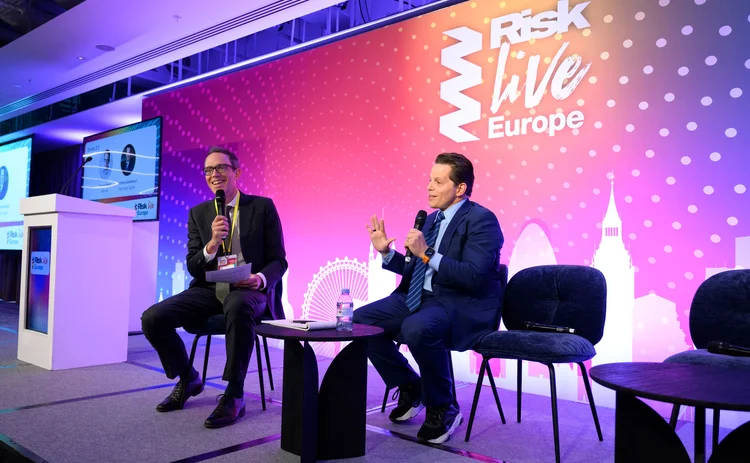
Trump getting stuck in Washington ‘swamp’, says Scaramucci
Risk Live: Former White House comms director says lobbyists have become effective constraint on Trump agenda

Washington lobbyists are beginning to constrain the power of US president Donald Trump, according to Anthony Scaramucci, former White House communications director, who opened the Risk Live Europe event in London on June 17.
Describing them as “the wolves of K Street”, Scaramucci said lobbyists are being paid by US companies to apply pressure “inside and outside the administration”.
“There are levers … in the system that I didn’t fully see until the last two months,” Scaramucci said.
“American business leaders have called up their lobbyists and said: ‘This does not work for me. How much money do I need to give [senators] Chuck Schumer, Rand Paul and Hakeem Jeffries? What do I have to do to further isolate and liquidate Trump’s power?’ And believe it or not, that is starting to work. That’s starting to creep into the system.”
You can hear the full recording of Scaramucci’s remarks here.
Lobbyists’ efforts are holding back the roll-out of the Project 2025 agenda that has widely been seen as a roadmap for the new administration. Trump sought to distance himself from its government-shrinking, power-grabbing tenets prior to last year’s election, after polling showed it to be unpopular with much of the electorate. Many of its authors now hold roles within the administration.
While the performance of bond markets was the primary factor in freezing Trump’s initial slate of tariffs – 10-year US Treasury yields jumped almost 50 basis points to hit 4.94% following the tariff announcement – Scaramucci says lobbyists have ramped up their activities and should be credited with triggering U-turns such as the recent halt in workplace raids by US Immigration and Customs Enforcement.
According to Scaramucci, lobbyists are telling politicians and White House officials: “‘We don’t like that policy. You’re going to be out of the administration in two years. You need to figure out a way to stop that policy.’ That’s a conversation going on in Washington.”

Scaramucci advised risk managers to read the Project 2025 agenda “because that’s what they really want to do”. He referred to a broad aim of liquidating levels of power in the judiciary and legislative branches of the US government.
“A secondary way to prepare yourself is to be patient. You’re going to have to wait this guy out. I’m actually more optimistic today than I’ve ever been,” he added, referring to the growing impact of lobbyists.
He expects a further pause on Trump’s ‘reciprocal’ tariffs of 45 or 90 days, when the current 90-day delay comes to an end on July 8.
The Musk party?
While Scaramucci doesn’t see any further role for Tesla boss Elon Musk in the Trump administration after his recent exit, he says the former chief of Trump’s department of government efficiency will try to find a new route to power.
“I honestly think Musk is going to try to start a third party,” he said, adding “three or four of his people have reached out to me to talk about what a third party would look like”.
“It would probably be a $50 billion or $100 billion endowment from very rich people that would turn into a potential third party movement,” said Scaramucci.
A new party would face high barriers in the form of federal campaign finance laws, state ballot access rules, and other features of the US electoral system.
“It’s almost impossible to do in the country,” he said, nodding towards a series of rule changes made after independent candidate Ross Perot gathered almost 20% of the vote in the 1992 election. “They clamped down and created this very tough duopoly, but with $100 billion, you can do a lot of things.”
Only users who have a paid subscription or are part of a corporate subscription are able to print or copy content.
To access these options, along with all other subscription benefits, please contact info@risk.net or view our subscription options here: http://subscriptions.risk.net/subscribe
You are currently unable to print this content. Please contact info@risk.net to find out more.
You are currently unable to copy this content. Please contact info@risk.net to find out more.
Copyright Infopro Digital Limited. All rights reserved.
As outlined in our terms and conditions, https://www.infopro-digital.com/terms-and-conditions/subscriptions/ (point 2.4), printing is limited to a single copy.
If you would like to purchase additional rights please email info@risk.net
Copyright Infopro Digital Limited. All rights reserved.
You may share this content using our article tools. As outlined in our terms and conditions, https://www.infopro-digital.com/terms-and-conditions/subscriptions/ (clause 2.4), an Authorised User may only make one copy of the materials for their own personal use. You must also comply with the restrictions in clause 2.5.
If you would like to purchase additional rights please email info@risk.net
More on Risk management
Review of 2025: It’s the end of the world, and it feels fine
Markets proved resilient as Trump redefined US policies – but questions are piling up about 2026 and beyond
BofA urges horizontal CCP fix after CME outage, others demur
Analysts say clearing meltdown bolsters case for futures-for-futures exchange with FMX
One in five banks targets a 30-day liquidity survival horizon
ALM Benchmarking research finds wide divergence in liquidity risk appetites, even among large lenders
Bank ALM tech still dominated by manual workflows
Batch processing and Excel files still pervade, with only one in four lenders planning tech upgrades
Many banks ignore spectre of SVB in liquidity stress tests
In ALM Benchmarking exercise, majority of banks have no internal tests focusing on stress horizons of less than 30 days
Quant Finance Master’s Guide 2026
Risk.net’s guide to the world’s leading quant master’s programmes, with the top 25 schools ranked
ALM Benchmarking: explore the data
View interactive charts from Risk.net’s 46-bank study, covering ALM governance, balance-sheet strategy, stress-testing, technology and regulation
Staff, survival days, models – where banks split on ALM
Liquidity and rate risks are as old as banking; but the 46 banks in our benchmarking study have different ways to manage them







